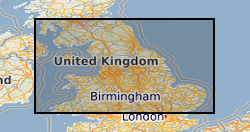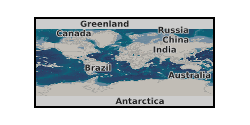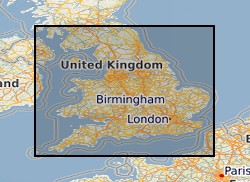1990
Type of resources
Topics
Keywords
Contact for the resource
Provided by
Years
Formats
Representation types
Update frequencies
Scale
Resolution
-
The Airborne Arctic Stratospheric Expedition (AASE) which was based in Stavanger, Norway during January and February, 1989, was designed to study the production and loss mechanisms of ozone in the north polar stratospheric environment, and the effect on ozone distribution of the Arctic polar vortex and of the cold temperatures associated with the formation of Polar Stratospheric Clouds (PSC). This dataset contains measurements from the meteorological meteorological measurement system on the NASA ER-2 Aircraft.
-

This is a simple Oracle table holding sample numbers, locations (UK National Grid) and illite crystallinity values measured for pelitic (mudrock) samples from Lower Palaeozoic terranes in the UK. Though intended for use by a BGS collaborative project with Birkbeck College, London, data may be made available to others on request.
-

The Seismic Line Index database stores summary administrative information about the collection of printed seismic sections, Original Seismic Sections dataset (ORIGSEISECS). This includes: details of data ownership or source, date of acquisition, purpose of survey, confidentiality, media, survey acquisition and processing parameters, and storage location in BGS. Almost all data are within the UK Onshore area; although there are some UK near-shore and offshore (North Sea, Irish Sea) and foreign data. Most data were acquired for commercial hydrocarbon exploration and subsequently provided to BGS for use on specific projects. Some data were acquired by BGS and other public-sector bodies, e.g. BIRPS (British Institutes Reflection Profiling Syndicate), for academic research. There is also scope to add relevant information about the data held in Copy Seismic Sections (COPYSEISECS) and Original Seismic Shotpoint Location Maps (ORIGSPMAPS) datasets.
-
This dataset consists of data from the Earth Radiation Budget Experiment (ERBE) instrument on the 10th NOAA Sun-synchronous operational satellites (NOAA-10). NOAA-10 operated at an altitude of 833-km, with an equatorial crossing local time of 0730, having been launched in November 1986. The ERBE instrument's main aim was to provide accurate measurements of incoming solar energy and shortwave and longwave radiation reflected or emitted from the Earth back into space. This dataset contains colour images (shortwave/longwave/net radiation, albedo, clear-sky albedo, clear-sky shortwave/longwave/net radiation, and shortwave/longwave/net cloud forcing) from scanning radiometer on the NOAA-10 satellite. Monthly average values are included for the time periods during which the scanners were operational. This dataset is public, though NASA noted that this is intended for research purposes and the data has no commercial value.
-
This dataset consists of data from the Earth Radiation Budget Experiment (ERBE) instrument on the 9th NOAA Sun-synchronous operational satellites (NOAA-9). NOAA-9 operated at an altitude of 852-km, with an equatorial crossing local time of 1430, having been launched in December 1984. The ERBE instrument's main aim was to provide accurate measurements of incoming solar energy and shortwave and longwave radiation reflected or emitted from the Earth back into space. This dataset contains colour images (shortwave/longwave/net radiation, albedo, clear-sky albedo, clear-sky shortwave/longwave/net radiation, and shortwave/longwave/net cloud forcing) from scanning radiometer on the NOAA-9 satellite. Monthly average values are included for the time periods during which the scanners were operational. This dataset is public, though NASA noted that this is intended for research purposes and the data has no commercial value.
-
The Earth Radiation Budget Experiment (ERBE) instrument aboard the NASA Earth Radiation Budget Satellite (ERBS) was launched from the Space Shuttle Challenger in October 1984 (STS-41G). The ERBE instrument's main aim was to provide accurate measurements of incoming solar energy and shortwave and longwave radiation reflected or emitted from the Earth back into space. This dataset collection contains colour images (shortwave/longwave/net radiation, albedo, clear-sky albedo, clear-sky shortwave/longwave/net radiation, and shortwave/longwave/net cloud forcing) from scanning radiometers on the three ERBE satellites and for combined satellite cases. Monthly average values are included for the time periods during which the scanners were operational.
-
The NASA Surface Radiation Budget (SRB) project computes Top-of atmosphere and Surface radiative fluxes at a 1ox 1o spatial scale for both shortwave (0.28– 4 mm) and longwave (4 mm) wavelengths. This dataset collection contains Version 1.1 Surface Radiation Budget (SRB) shortwave products for the period from March 1985 until December 1988 as produced by the World Climate Research Programme's (WCRP) SRB Satellite Data Analysis Center (SDAC). The data are derived from results from the International Satellite Cloud Climatology Project (ISCCP) and the Earth Radiation Budget Experiment (ERBE).
-

Oracle index to records of some 3500 waste sites in England and Wales identified by BGS as part of a survey carried out on behalf of the Departement of the Environment in 1973. The index has been corrected and updated to a limited extent, but the data itself has not been changed. The data was collected in 1972 and the information reflects the knowledge at that time. It does not reflect current interpretation. Not all authorities made returns and there are not records for all of the sites listed. However, the data is an invaluable source of information about pre-1974 sites. Information includes site name, location and risks to aquifers. It should be noted that the assessments were carried out when the data was collected and may not reflect current interpretation.
-
This dataset consists of invertebrate species records, sampled from headwater streams during a survey in 1990. Macro-invertebrates were sampled using standard protocols. The sample area in each stream was a single area of stream-bed whose major habitat types can be sampled within the recommended sampling period of three minutes of active sampling, supplemented by a one minute hand search. The length of river surveyed would normally vary from 5 to 15m. Samples were collected using a standard 1mm mesh pond net and returned to the Centre for Ecology & Hydrology (formerly Institute of Freshwater Ecology) for later sorting and identification. Supplemental physical measurements (width, depth, substrate composition) required to run RIVPACS (River Invertebrate Prediction and Classification System) were taken. Data were collected under the Countryside Survey long term monitoring project managed by the Centre for Ecology & Hydrology. The Countryside Survey is a unique study or 'audit' of the natural resources of the UK's countryside. The sample sites are chosen from a stratified random sample, based on a 15 by 15 km grid of GB. Headwater stream surveys have been carried out in 1990, 1998 and 2007 with repeated visits to the majority of sites. The countryside is sampled and surveyed using rigorous scientific methods, allowing us to compare new results with those from previous surveys. In this way we can detect the gradual and subtle changes that occur in the UK's countryside over time. In addition to headwater stream data, soil data, habitat areas, vegetation species data and linear habitat data are also gathered by Countryside Survey. Full details about this dataset can be found at https://doi.org/10.5285/b4c17f35-1b50-4ed7-87d2-b63004a96ca2
-
This dataset consists of stock (length) data for landscape linear features across Great Britain in 1990. Data are presented as lengths of different feature categories (such as fences, walls and lines of trees), with associated species attributes, from 506 km squares, surveyed for the Countryside Survey long term monitoring project (note: not all surveyed squares contained linear features). The Countryside Survey is a unique study or 'audit' of the natural resources of the UK's countryside, carried out by the Centre for Ecology & Hydrology. The sample sites are chosen from a stratified random sample, based on a 15 by 15 km grid of GB. Surveys have been carried out in 1978, 1984, 1990, 1998 and 2007 with repeated visits to the majority of squares. The countryside is sampled and surveyed using rigorous scientific methods, allowing us to compare new results with those from previous surveys. In this way we can detect the gradual and subtle changes that occur in the UK's countryside over time. In addition to linear features, habitat areas, vegetation species plot, soil plot, freshwater habitat and satellite map data are also produced by Countryside Survey. Full details about this dataset can be found at https://doi.org/10.5285/311daad4-bc8c-485a-bc8a-e0d054889219
 NERC Data Catalogue Service
NERC Data Catalogue Service